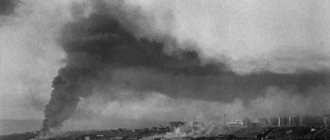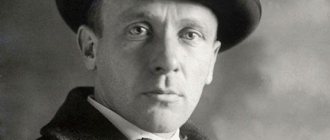Childhood and first works
Nikolai Stepanovich Gumilev was born on April 3 (15), 1886 in Kronstadt, in the family of a ship’s doctor. The future writer spent his childhood first in Tsarskoe Selo, and then in the city of Tiflis. In 1902, Gumilyov’s first poem “I fled to the forest from the cities...” was published.
In 1903, Nikolai Stepanovich entered the 7th grade of the Tsarskoye Selo gymnasium. In the same year, the writer met his future wife, Anna Gorenko (Akhmatova).
In 1905, a most important event occurred in Gumilyov’s short biography - the poet’s first collection, “The Path of the Conquistadors,” was published.
Training and arrests, participation in the war
Lev Nikolaevich entered the Leningrad State University, Faculty of History, in 1934. However, after completing his first year, he was arrested for the first time. Soon Lev Gumilyov was released, but he never managed to graduate from the university. Already in his 4th year, in 1938, he was again arrested for participation in a student terrorist organization. Gumilev was sentenced to 10 years in the camps. Later his fate was softened. Lev Nikolaevich should have served a 5-year sentence in Norilsk. After this time, in 1943, he worked for hire in Turukhansk and near Norilsk. Then Gumilyov went to the front. He fought as an anti-aircraft gunner until victory. Gumilyov Lev Nikolaevich reached Berlin itself. The short biography of this scientist, as you can see, is marked not only by achievements in the field of history.
Mature creativity. Trips
After graduating from high school in 1906, Gumilyov went to Paris and entered the Sorbonne. While in France, Nikolai Stepanovich tried to publish the magazine “Sirius” (1907), an exquisite magazine for those times. In 1908, the writer’s second collection, “Romantic Flowers,” dedicated to Anna Akhmatova, was published. This book marked the beginning of Gumilyov's mature work.
Nikolai Stepanovich returns to Russia, but soon leaves again. The writer visits Sinop, Istanbul, Greece, Egypt, and African countries with expeditions.
In 1909, Gumilyov entered St. Petersburg University, first to the Faculty of Law, but then transferred to the Faculty of History and Philology. The writer takes an active part in the creation of the Apollo magazine. In 1910, the collection “Pearls” was published, which received positive reviews from V. Ivanov, I. Annensky, V. Bryusov. The book includes the famous work of the writer “Captains”.
In April 1910, Gumilev married Anna Akhmatova.
short biography
Childhood and youth
Born into the noble family of the Kronstadt ship doctor Stepan Yakovlevich Gumilyov (1836-1910). Mother - Anna Ivanovna, née Lvova (1854-1942).
As a child, Nikolai Gumilyov was a weak and sickly child: he was constantly tormented by headaches and could not tolerate noise well. According to Anna Akhmatova (“The Works and Days of N. Gumilyov,” vol. II), the future poet wrote his first quatrain about the beautiful Niagara at the age of six.
He entered the Tsarskoye Selo gymnasium in the fall of 1894, however, after studying for only a few months, due to illness he switched to home schooling.
In the fall of 1895, the Gumilyovs moved from Tsarskoye Selo to St. Petersburg, rented an apartment in the house of merchant N.V. Shalin on the corner of Degtyarnaya and 3rd Rozhdestvenskaya streets, and the next year Nikolai Gumilyov began studying at the Gurevich gymnasium. In 1900, the elder brother Dmitry (1884-1922) was diagnosed with tuberculosis, and the Gumilyovs left for the Caucasus, to Tiflis. In connection with the move, Nikolai entered the fourth grade for the second time, the 2nd Tiflis Gymnasium, but six months later, on January 5, 1901, he was transferred to the 1st Tiflis Men's Gymnasium. Here, in the “Tiflis Leaflet” of 1902, the poem was first published N. Gumilyov “I fled to the forest from the cities...”.
In 1903, the Gumilyovs returned to Tsarskoye Selo and Nikolai Gumilyov in 1903 again entered the Tsarskoye Selo gymnasium (in the 7th grade). He studied poorly and once was even on the verge of expulsion, but the director of the gymnasium, I.F. Annensky, insisted on leaving the student for the second year: “All this is true, but he writes poetry.”
. In the spring of 1906, Nikolai Gumilyov nevertheless passed the final exams and on May 30 received a certificate of maturity No. 544, which included a single “A” - according to logic.
A year before graduating from high school, the first book of his poems, “The Path of the Conquistadors,” was published at the expense of his parents. This collection was given a special review by Valery Bryusov, one of the most authoritative poets of that time. Although the review was not laudatory, the master concluded it with the words “Let us assume that it [the book] is only the “path” of the new conquistador and that his victories and conquests are ahead.”
, it was after this that correspondence began between Bryusov and Gumilev. For a long time, Gumilyov considered Bryusov his teacher; Bryusov’s motifs can be traced in many of his poems (the most famous of them is “The Violin,” however, dedicated to Bryusov). The master patronized the young poet for a long time and treated him, unlike most of his students, kindly, almost in a fatherly way.
After graduating from high school, Gumilev went to study at the Sorbonne.
Abroad
Photo from 1906
Since 1906, Nikolai Gumilyov lived in Paris: he attended lectures on French literature at the Sorbonne, studied painting, and traveled a lot. Visited Italy and France. While in Paris, he published the literary magazine Sirius (in which Anna Akhmatova made her debut), but only 3 issues of the magazine were published. He visited exhibitions, met French and Russian writers, and was in intensive correspondence with Bryusov, to whom he sent his poems, articles, and stories. At the Sorbonne, Gumilyov met the young poetess Elizaveta Dmitrieva. This fleeting meeting played a fatal role in the poet’s fate a few years later.
Photo of Maximilian Voloshin, Gumilyov N.S. in Paris, 1906.
In Paris, Bryusov recommended Gumilyov to such famous poets as Merezhkovsky, Gippius, Bely and others, but the masters treated the young talent carelessly. In 1908, the poet “revenged” the insult by anonymously sending them the poem “Androgyne.” It received extremely favorable reviews. Merezhkovsky and Gippius expressed a desire to meet the author.
In 1907, in April, Gumilyov returned to Russia to go through the draft board. In Russia, the young poet met his teacher, Bryusov, and his lover, Anna Gorenko. In July, he set off from Sevastopol on his first trip to the Levant and returned to Paris at the end of July. There is no information about how the trip went, except for letters to Bryusov.
after our meeting, I was in the Ryazan province, in St. Petersburg, lived for two weeks in the Crimea, a week in Constantinople, in Smyrna, had a fleeting affair with some Greek woman, fought with the Apaches in Marseilles and only yesterday, I don’t know how, I don’t know why , found myself in Paris.
There is a version that it was then that Gumilyov first visited Africa, this is also evidenced by the poem “Ezbekiye,” written in 1917 (How strange - exactly ten years have passed // Since I saw Ezbekiye). However, chronologically this is unlikely.
In 1908, Gumilyov published the collection “Romantic Flowers”. Sergei Makovsky wrote about him: “The poems seemed to me rather weak even for an early book. However, with the exception of one thing - “Ballad”; it struck me with a tragic tone.”
With the money received for the collection, as well as with the funds accumulated by his parents, he goes on a second journey. Arrived in Sinop, where I had to quarantine for 4 days, and from there to Istanbul. After Turkey, Gumilev visited Greece, then went to Egypt, where he visited Ezbikiye. In Cairo, the traveler suddenly ran out of money and was forced to go back. On November 29 he was again in St. Petersburg.
Nikolai Gumilyov is not only a poet, but also one of the largest researchers in Africa. He made several expeditions to East and North-East Africa and brought a rich collection to the Museum of Anthropology and Ethnography (Kunstkamera) in St. Petersburg.
First expedition to Abyssinia
Africa attracted Gumilyov since childhood; he was inspired by the exploits of Russian volunteer officers in Abyssinia (later he would even repeat the route of Alexander Bulatovich and partly the routes of Nikolai Leontyev). Despite this, the decision to go there came suddenly, and on September 25 he went to Odessa, from there to Djibouti, then to Abyssinia. The details of this trip are unknown. It is only known that he visited Addis Ababa for a ceremonial reception at the Negus. The friendly relations of mutual sympathy that arose between the young Gumilyov and the experienced Menelik II can be considered proven. In the article “Is Menelik Dead?” the poet both described the unrest that took place under the throne and revealed his personal attitude to what was happening.
Between trips
The three years between expeditions were very eventful in the poet’s life.
Gumilyov and Akhmatova with their son
Gumilyov visits the famous “Tower” of Vyacheslav Ivanov and the Society of Admirers of the Artistic Word, where he makes many new literary acquaintances.
In 1909, together with Sergei Makovsky, Gumilyov organized an illustrated magazine on issues of fine art, music, theater and literature “Apollo”, in which he began to head the literary criticism department and published his famous “Letters on Russian Poetry”.
In the spring of the same year, Gumilev meets Elizaveta Dmitrieva again, and they begin an affair. Gumilyov even invites the poetess to marry him. But Dmitrieva prefers another poet and his colleague on the Apollo editorial board, Maximilian Voloshin, to Gumilyov. In the fall, when the personality of Cherubina de Gabriac, a literary hoax of Voloshin and Dmitrieva, is scandalously exposed, Gumilyov allows himself to speak unflatteringly about the poetess, Voloshin publicly insults him and receives a challenge. The duel took place on November 22, 1909, and news about it appeared in many metropolitan magazines and newspapers. Both poets remained alive: Voloshin shot—it misfired, again—it misfired again, Gumilyov shot upward.
In 1910, the collection “Pearls” was published, in which “Romantic Flowers” was included as one of the parts. “Pearls” includes the poem “Captains,” one of the most famous works of Nikolai Gumilyov. The collection received laudatory reviews from V. Bryusov, V. Ivanov, I. Annensky and other critics, although it was called “still a student’s book”
.
On April 25, 1910, after three years of hesitation, he finally got married: in the St. Nicholas Church in the village of Nikolskaya Slobodka, on the outskirts of the city of Kyiv, Gumilyov married Anna Andreevna Gorenko (Akhmatova).
In 1911, with the active participation of Gumilyov, the “Workshop of Poets” was founded, which, in addition to Gumilyov, included Anna Akhmatova, Osip Mandelstam, Vladimir Narbut, Sergei Gorodetsky, Elizaveta Kuzmina-Karavaeva (the future “Mother Maria”), Zenkevich and others.
At this time, symbolism was experiencing a crisis, which young poets sought to overcome. They declared poetry to be a craft, and all poets were divided into masters and apprentices. In the “Workshop” Gorodetsky and Gumilyov were considered masters, or “syndics”. Initially, “The Workshop” did not have a clear literary orientation. At the first meeting, which took place at Gorodetsky’s apartment, there were Piast, Blok and his wife, Akhmatova and others. Blok wrote about this meeting:
A carefree and sweet evening. The youth. Anna Akhmatova. Conversation with N.S. Gumilyov and his good poems. It was fun and simple. You get better with young people.
In 1912, Gumilyov announced the emergence of a new artistic movement—Acmeism, which included members of the “Workshop of Poets.” Acmeism proclaimed materiality, objectivity of themes and images, precision of words. The emergence of a new trend caused a stormy reaction, mostly negative. In the same year, Acmeists opened their own publishing house “Hyperborea” and a magazine of the same name.
Gumilev enters the Faculty of History and Philology of St. Petersburg University, where he studies Old French poetry.
In the same year, the poetry collection “Alien Sky” was published, in which, in particular, the first, second and third cantos of the poem “The Discovery of America” were published.
On October 1 of the same year, Anna and Nikolai Gumilyov had a son, Lev.
Second expedition to Abyssinia
The second expedition took place in 1913. It was better organized and coordinated with the Academy of Sciences. At first, Gumilyov wanted to cross the Danakil Desert, study little-known tribes and try to civilize them, but the Academy rejected this route as expensive, and the poet was forced to propose a new route:
I had to go to the port of Djibouti from there by rail to Harrar, then, forming a caravan, to the south, to the area between the Somali Peninsula and lakes Rudolph, Margaret, Zwai; cover as large a study area as possible.
His nephew Nikolai Sverchkov went to Africa with Gumilyov as a photographer.
First, Gumilyov went to Odessa, then to Istanbul. In Turkey, the poet showed sympathy and sympathy for the Turks, unlike most Russians. There, Gumilyov met the Turkish consul Mozar Bey, who was traveling to Harar; they continued their journey together. From Istanbul they headed to Egypt, and from there to Djibouti. The travelers were supposed to go inland by rail, but after 260 kilometers the train stopped due to the fact that the rains washed out the path. Most of the passengers returned, but Gumilyov, Sverchkov and Mozar Bey begged the workers for a handcar and drove 80 kilometers of damaged track on it. Arriving in Dire Dawa, the poet hired a translator and set off in a caravan to Harar.
Haile Selassie I
In Harar, Gumilyov bought mules, not without complications, and there he met Ras Tefari (then governor of Harar, later Emperor Haile Selassie I; adherents of Rastafarianism consider him the incarnation of God - Jah). The poet gave the future emperor a box of vermouth and photographed him, his wife and sister. In Harare, Gumilyov began collecting his collection.
Aba Muda
From Harar the path lay through the little-explored Galla lands to the village of Sheikh Hussein. On the way, we had to cross the fast-water Uabi River, where Nikolai Sverchkov was almost dragged away by a crocodile. Soon problems with provisions began. Gumilyov was forced to hunt for food. When the goal was achieved, the leader and spiritual mentor of Sheikh Hussein Aba-Muda sent provisions to the expedition and warmly received it. This is how Gumilyov described it:
A fat black man sat on Persian carpets in a dim, undecorated room, like an idol, wearing bracelets, earrings and rings, only his eyes sparkled marvelously. - "Galla"
There Gumilyov was shown the tomb of Saint Sheikh Hussein, after whom the city was named. There was a cave there, from which, according to legend, a sinner could not get out:
I had to undress and crawl between the stones into a very narrow passage. If anyone got stuck, he died in terrible agony: no one dared to extend a hand to him, no one dared to give him a piece of bread or a cup of water...
Gumilyov climbed there and returned safely.
Having written down the life of Sheikh Hussein, the expedition moved to the city of Ginir. Having replenished the collection and collected water in Ginir, the travelers went west, on a difficult journey to the village of Matakua.
The further fate of the expedition is unknown; Gumilyov’s African diary is interrupted at the word “Road...” on July 26. According to some reports, on August 11, the exhausted expedition reached the Dera Valley, where Gumilev stayed in the house of the parents of a certain Kh. Mariam. He treated his mistress for malaria, freed a punished slave, and his parents named their son after him. However, there are chronological inaccuracies in the Abyssinian's story. Be that as it may, Gumilyov safely reached Harar and in mid-August was already in Djibouti, but due to financial difficulties he was stuck there for three weeks. He returned to Russia on September 1.
World War I
The beginning of 1914 was difficult for the poet: the workshop ceased to exist, difficulties arose in his relationship with Akhmatova, and he became bored with the bohemian life he led after returning from Africa.
After the outbreak of the First World War in early August 1914, Gumilev volunteered for the army. Together with Nikolai, his brother Dmitry Gumilyov, who was shell-shocked in battle and died in 1922, went to war (by conscription).
It is noteworthy that although almost all the famous poets of that time composed either patriotic or military poems, only two took part in the hostilities as volunteers: Gumilyov and Benedikt Livshits.
Gumilyov was enlisted as a volunteer in the Life Guards Ulan Regiment of Her Majesty. In September and October 1914, exercises and training took place. Already in November the regiment was transferred to Southern Poland. On November 19, the first battle took place. For night reconnaissance before the battle, by Order of the Guards Cavalry Corps of December 24, 1914 No. 30, he was awarded the Cross of St. George, 4th degree No. 134060 and promoted to the rank of corporal. The cross was awarded to him on January 13, 1915, and on January 15 he was promoted to non-commissioned officer.
At the end of February, as a result of continuous hostilities and travel, Gumilyov fell ill with a cold:
We advanced, knocked the Germans out of villages, went on trips, I also did all this, but as in a dream, now shivering with chills, now burning in the heat. Finally, after one night, during which I made at least twenty rounds and fifteen escapes from captivity without leaving the hut, I decided to take my temperature. The thermometer showed 38.7.
The poet was treated for a month in Petrograd, then was returned to the front again.
In 1915, from April to June, although there were no active hostilities, Gumilyov participated in reconnaissance trips almost every day.
In 1915, Nikolai Gumilyov fought in Volyn. Here he went through the most difficult military trials and received the 2nd Cross of St. George, of which he was very proud. Anna Akhmatova responded to this somewhat skeptically:
They rarely fly to our porch. We gave a white cross to your father.
So she wrote to her little son Lev.
On July 6, a large-scale enemy attack began. The task was set to hold positions until the infantry approached, the operation was carried out successfully, and several machine guns were saved, one of which was carried by Gumilyov. For this, by Order of the Guards Cavalry Corps dated December 5, 1915 No. 1486, he was awarded the insignia of the Military Order of the Cross of St. George, 3rd degree No. 108868.
In September, the poet returned to Russia as a hero, and on March 28, 1916, by order of the Commander-in-Chief of the Western Front No. 3332, he was promoted to ensign and transferred to the 5th Hussar Regiment of Alexandria. Using this respite, Gumilyov was active in literary activity.
In April 1916, the poet arrived in the hussar regiment stationed near Dvinsk. In May, Gumilev was again evacuated to Petrograd. The night jump in the heat described in “Notes of a Cavalryman” cost him pneumonia. When the treatment was almost over, Gumilyov went out into the cold without permission, as a result of which the disease worsened again. Doctors recommended that he undergo treatment in the south. Gumilev left for Yalta. However, the poet’s military life did not end there. On July 8, 1916, he again went to the front, again for a short time. On August 17, by order of regiment No. 240, Gumilev was sent to the Nikolaev Cavalry School, then again transferred to the front and remained in the trenches until January 1917.
In 1916, a collection of poems, “Quiver,” was published, which included poems on a military theme.
In 1917, Gumilev decided to transfer to the Thessaloniki Front and went to the Russian expeditionary force in Paris. He went to France along the northern route - through Sweden, Norway and England. Gumilyov stayed in London for a month, where he met the poet William Butler Yeats and the writer Gilbert Chesterton. Gumilev left England in an excellent mood: paper and printing costs turned out to be much cheaper there, and he could print Hyperborea there.
Arriving in Paris, he served as an adjutant to the commissar of the Provisional Government, where he became friends with artists M.F. Larionov and N.S. Goncharova.
In Paris, the poet fell in love with the half-Russian, half-French Elena Karolovna du Boucher, the daughter of a famous surgeon. He dedicated the collection of poems “To the Blue Star” to her. Soon Gumilyov moved to the 3rd brigade. However, the decay of the army was felt there too. Soon the 1st and 2nd brigades mutinied. He was suppressed, and Gumilyov personally took part in the suppression; many soldiers were deported to Petrograd, the rest were united into one special brigade.
On January 22, 1918, Anrep got him a job in the encryption department of the Russian Government Committee. Gumilyov worked there for two months. However, bureaucratic work did not suit him, and on April 10, 1918, the poet left for Russia.
In Soviet Russia
In 1918, the collection “Bonfire” was published, as well as the African poem “Mick”. The prototype of Louis, the monkey king, was Lev Gumilyov. The timing of the fairy-tale poem's release was unfortunate, and it was received coolly. His fascination with the Malay pantun dates back to this period—part of the play “Child of Allah” (1918) was written in the form of a stitched pantun.
On August 5, 1918, a divorce from Anna Akhmatova took place. Relations between the poets went wrong a long time ago, but it was impossible to divorce with the right to remarry before the revolution.
In 1919, he married Anna Nikolaevna Engelgardt, the daughter of the historian and literary critic N.A. Engelgardt.
In 1918-1920, Gumilyov gave lectures on poetic creativity at the Institute of the Living Word.
In 1920, the Petrograd department of the All-Russian Union of Poets was established, and Gumilyov also joined it. Formally, Blok was elected head of the Union, but in fact the Union was governed “more than pro-Bolshevik”
a determined group of poets led by Pavlovich. Under the pretext that a quorum was not reached in the election of the chairman, re-elections were called. The Pavlovich camp, believing that this was a simple formality, agreed, but at the re-election Gumilyov was unexpectedly nominated, who won by one vote.
Gorky took a close part in the affairs of the department. When Gorky’s plan “The History of Culture in Pictures” for the publishing house “World Literature” arose, Gumilyov supported these endeavors. His “Poisoned Tunic” could not have come at a better time. In addition, Gumilyov gave sections of the play “Gondla”, “Hunting the Rhinoceros” and “The Beauty of Morni”. The fate of the latter is sad: its full text has not survived.
In 1921, Gumilyov published two collections of poems. The first is “The Tent,” written based on impressions from traveling in Africa. “The Tent” was supposed to be the first part of a grandiose “geography textbook in verse.” In it, Gumilyov planned to describe the entire inhabited land in rhyme. The second collection is “Pillar of Fire,” which includes such significant works as “The Word,” “The Sixth Sense,” and “My Readers.” Many believe that “Pillar of Fire” is the poet’s pinnacle collection.
Since the spring of 1921, Gumilyov headed the Sounding Shell studio, where he shared his experience and knowledge with young poets and gave lectures on poetics.
Living in Soviet Russia, Gumilyov did not hide his religious and political views—he openly baptized himself in churches and declared his views. So, at one of the poetry evenings, when asked from the audience, “What are your political beliefs?”
replied,
. ”
Arrest and execution
Nikolay Gumilyov. Photo from the investigation case. 1921
On August 3, 1921, Gumilyov was arrested on suspicion of participation in the conspiracy of the “Petrograd Combat Organization of V.N. Tagantsev.” For several days, Mikhail Lozinsky and Nikolai Otsup tried to help their friend out, but despite this, the poet was soon executed.
Monument to Nikolai Gumilyov in Koktebel
On August 24, the Petrograd GubChK issued a decree on the execution of participants in the “Tagantsevsky conspiracy” (61 people in total), published on September 1, indicating that the sentence had already been carried out. Gumilyov and 56 other convicts, as established in 2014, were shot on the night of August 26. The place of execution and burial is still unknown; this is not indicated in the newly discovered documents. The following versions are common:
- Bernhardovka (Valley of the Lubya River) in Vsevolozhsk. Bridge over the Lubya River, a memorial cross is installed on the bank.
- The Fox Nose pier area, behind the gunpowder warehouses. A remote area near the Razdelnaya railway station (now Lisiy Nos) was previously used as a place for executions following sentences of military courts.
- Anna Akhmatova believed that the place of execution was on the outskirts of the city towards the Porokhovs.
- Kovalevsky forest, in the area of the arsenal of the Rzhevsky training ground, at the bend of the Lubya River.
Cross cenotaph at the probable location of Gumilyov’s execution. Berngardovka (Lubya River valley)
The pier in Lisiy Nos is a traditional place of executions in St. Petersburg and a possible place of execution of Gumilyov
Only in 1992 was Gumilyov rehabilitated.
Versions of events of 1921
There are three versions about Gumilyov’s involvement in V.N. Tagantsev’s conspiracy:
- Gumilyov participated in the conspiracy - the official Soviet version of 1921-1987, supported by some emigrants who knew the poet and a number of biographers, for example, V. Shubinsky.
- Gumilyov did not participate in the conspiracy, but only knew about it and did not report it - a version of the 1960s, widespread in the USSR during perestroika (1987-1991) and today.
- The conspiracy did not exist at all; it was completely fabricated by the Cheka in connection with the Kronstadt uprising - one of the modern versions.
“The Workshop of Poets” and Acmeism. First World War
In 1911, with the participation of Gumilev, the poetic association “Workshop of Poets” was created, which included O. Mandelstam, S. Gorodetsky, V. Narbut, M. Zenkevich, E. Kuzmina-Karavaeva. In 1912, Nikolai Stepanovich announced the emergence of a new artistic movement, Acmeism, and soon the magazine “Hyperborea” was created, and Gumilyov’s collection “Alien Sky” was published. In 1913, the writer again went to the East.
With the outbreak of the First World War, Gumilev, whose biography was already full of extraordinary events, voluntarily went to the front and was awarded two St. George's Crosses for his bravery. While serving in Paris in 1917, the poet fell in love with Helene du Boucher and dedicated a collection of poems, To the Blue Star, to her.
The main provisions of Gumilyov's theory
Lev Gumilev based his theory on the assertion that “ethnic groups” are a kind of biological organisms. They have periods of youth, maturity and old age. Gumilev included in the number of ethnic groups not only ethnic groups themselves, but also political, confessional and even professional ones. He believed that about 1200-1500 years passed from their birth to death. According to the scientist’s concept, the emergence of new ethnic groups occurs as a result of a “passionary push”, which is provoked by radiation from space. There are those that are “complementary” to each other, and there are also antagonistic ones. In addition to healthy ones, there are also “chimerical”, malicious ethnic groups that parasitize the organisms of others. Healthy people have different ways of interacting with the climatic environment and the “feeding landscape” and differ in these characteristics.
Gumilyov created his theory, trying to understand why wave-like and rapid ethnic processes were observed in the Great Steppe during the Middle Ages and antiquity. Indeed, they were often, in one way or another, associated with changes in climatic conditions. Therefore, to some extent, scientists’ linking landscape and ethnicity is justified. Nevertheless, the “theory of ethnogenesis” lost its credibility as a result of Gumilyov’s absolutization of the role of natural factors. The term “passionarity”, which belonged to Lev Nikolaevich, began to live its own life. The scholar used it to refer to the original ethnic activism. However, now this term has nothing in common with Gumilev’s “theory of ethnogenesis.”
On June 15, 1992, Lev Gumilyov died in St. Petersburg. The biography, family and heritage of the scientist were briefly reviewed by us. Now you know why the son of two great Russian poets gained great popularity.
Post-war years. Death
In 1918, Gumilyov returned to Russia. In August of the same year, the writer divorced Akhmatova.
In 1919–1920, the poet worked at the World Literature publishing house, taught, and translated from English and French. In 1919 he married Anna Engelhardt, daughter of N. Engelhardt. Gumilyov's poems from the collection “Pillar of Fire” (1921) are dedicated to his second wife.
In August 1921, Nikolai Gumilev was arrested on charges of participation in the anti-government “Tagantsev conspiracy.” Three weeks later he was sentenced to death, executed the very next day. The exact date of execution and burial place of Nikolai Stepanovich Gumilyov are unknown.
Interesting Facts
- In 1909, Gumilev took part in an absurd duel with M. Voloshin because Nikolai Stepanovich spoke unflatteringly about the poetess Elizaveta Dmitrieva. Both poets did not want to shoot themselves, Gumilev fired into the air, Voloshin’s pistol misfired.
- In 1916, Gumilyov was enlisted in the special Fifth Alexandria Hussar Regiment, whose soldiers took part in the most fierce battles near Dvinsk.
- Anna Akhmatova always criticized Gumilyov's poetry. This often led to the poet burning his works.
- For a long time, Gumilyov's works were not published. The poet was rehabilitated only in 1992.
- Two documentaries were made about Gumilyov’s life – “Testament” (2011) and “New Version. Gumilyov against dictatorship" (2009).
Passionarity and ethnogenesis
The most famous part of the scientific heritage that Lev Gumilev left is the theory of ethnogenesis and passionarity. The first article on this topic was published by him in 1970. Gumilyov called passionarity the super-intense activity of a person in his desire to achieve a certain goal. The historian superimposed this phenomenon on the doctrine of the formation of ethnic groups.
Lev Gumilyov’s theory stated that the survival and success of a people depends on the number of passionaries in it. The scientist did not consider this factor to be the only one, but defended its importance in the process of formation and displacement of ethnic groups by competitors. The passionary theory of Lev Gumilyov, which caused serious scientific controversy, stated that the reason for the emergence of a large number of leaders and extraordinary personalities are cyclical passionary impulses.
This phenomenon is rooted in biology, genetics and anthropology. As a result, superethnoses arose, Lev Gumilyov believed. The scientist’s books included hypotheses about the reasons for the origin of passionary impulses. The author also called them energy impulses of a cosmic nature.











